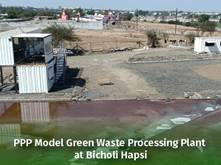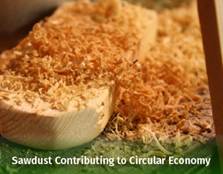Under the Swachh Bharat Mission-Urban, Indore is poised to achieve a major milestone with the launch of India’s first green waste processing plant, developed through a Public-Private Partnership (PPP) model.

Indore is all set to make a significant leap towards environmental sustainability with the launch of India’s first PPP-model based green waste processing plant under the Swachh Bharat Mission-Urban. This groundbreaking initiative, aims to revolutionize the city’s waste management system by converting green waste into valuable resources. This project underscores the city’s commitment to innovation and sustainability in tackling urban waste challenges.

The facility will not only process green waste but also generate revenue, with the Indore Municipal Corporation (IMC) earning approx. Rs 3,000 per tonne in royalty for supplying wood and branches. Built on a 55,000 square feet land in Bicholi Hapsi, the plant will recycle wood and branches to produce wooden pellets, serving as an alternative to coal and promoting energy conservation.
Branches of large trees will be redirected to the Green Waste Processing Plant at City Forest, where they will be repurposed into valuable products. In addition, green waste generated from the premises of major institutions will be directly collected and sent to the facility, with a fixed fee structure in place. Every day, the bustling city of Indore generates approximately 30 tons of green waste—wood, branches, leaves, and flowers. As the seasons change, especially during autumn, this volume can soar to 60 to 70 tons.
Partnering with the Indore Municipal Corporation, Astronomical Industries Private Limited embarked on an ambitious initiative to transform the city’s green waste into something both sustainable and valuable—a fine sawdust that could be used across a wide array of industries. With a detailed plan in place, the idea is to dry the green waste over a span of three to four months. During this time, the moisture content would decrease by 90%, preparing the material for the next stage. As the months pass by, the green waste, once damp and cumbersome, would become light and brittle, almost ready for transformation. cutting edge machines will then help to break it down into fine dust particles - saw dust. Once an unremarkable byproduct of timber mills, now has a second life, contributing to a sustainable, circular economy.

The saw dust can be transformed into eco-friendly fuel, providing a cleaner alternative to traditional burning methods. It can be used to craft durable packing materials that reduce the need for plastic. Furniture manufacturers find it useful as a composite material, lending strength to products like chairs and tables. Fertilizers made from the sawdust enriches the soil, helping farmers grow healthier crops. And in the food industry, the sawdust can be moulded into disposable plates, offering a biodegradable alternative to plastic and Styrofoam.
Under the Swachh Bharat Mission, the IMC will play a pivotal role by providing and transporting land and green waste to the plant. Meanwhile, the private company will take on the responsibility of setting up the remaining infrastructure, including sheds, electricity, and water facilities. The private firm will also oversee the complete installation and operation of the plant, ensuring its smooth functioning from start to finish.
Other private firms have set up the Meghdoot and sub-grade plants, spanning an area of 10,000 to 15,000 square feet in Sirpur. These facilities are dedicated to processing garden waste, such as leaves and small twigs, sourced from the municipal corporation. As part of this initiative, composting is also being carried out in specially designed compost pits located within the municipal gardens, further enhancing waste management efforts. Wooden pellets, produced from green waste, are utilized across various industries, including the National Thermal Power Corporation (NTPC), where they serve as an eco-friendly alternative for energy production and other applications.


The goal of this initiative is to efficiently manage green waste, promote environmental sustainability, and create additional revenue streams for the Municipal Corporation. It also plays a crucial role in controlling the Air Quality Index (AQI). By improving waste management practices, this initiative will enhance hygiene, reduce pollution, and curb the unnecessary burning of waste, contributing to a cleaner and healthier environment.
The project will also provide an alternative source of coal, contributing to AQI control while offering an effective solution for cleanliness and environmental protection. This initiative aligns with the vision of Garbage-Free Cities under the Swachh Bharat Mission-Urban, advancing efforts toward a cleaner, greener, and more sustainable urban environment.









